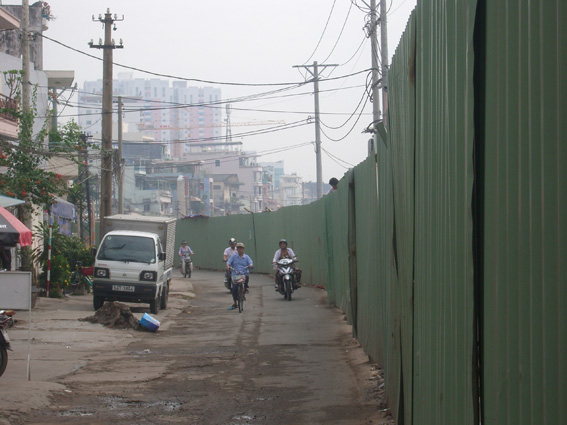Since China’s economic rise, the ironies of ‘market socialism’ have become something of a staple of international journalism. Indeed, the story of socialism yielding to neoliberal economics can be sketched in sharp, simple contrasts: Mao and Motorola; Deng and Disney; Tiananmen and Toyota. But despite all of this — and all irony aside — I am constantly taken aback by the sheer capitalistic dynamism of the city that bears Ho Chi Minh’s name. The pace of development here is dizzying.
Two years ago, the Ben Nghe waterfront was a symphony of flaking stucco, lined with squat colonial-era houses and shop fronts. Today, the doctrine of development-at-all-costs reigns supreme: trucks roar along the canal, hauling concrete; new bridges stretch crenellated arms over the water. Across the water in District 8, high-rises have shot out of the mud, sheathed in green gauze. Alongside the usual Party exhortations, signs on Tran Hung Dao Street intone a new mantra — ‘Ho Chi Minh City Construction and Development!’ — a sentiment which now seems to dominate Vietnam’s state-approved ‘socialist’ lexicon. The only thing left untouched is the half-formed concrete monstrosity in the park between Pham Ngu Lao and Le Lai Streets, a decade-old testament to the failures of planned economics, now streaked with grime and reeking of urine.

Construction works along the Ben Nghe canal.
While I am very pro-development — after decades of war and upheaval, Vietnam surely deserves its place in the sun — it’s regrettable that it so often involves the desecration of the urban landscape. The new Petro-Vietnam tower on Le Duan Road, encased in reflective glass, is a case in point. Unfortunately, these sorts of architectural prophylactics are the downside of capitalist development, which no reasonable person would deny a developing country like Vietnam. The romance of poverty and decay, so often accompanied by middle-class bromides about the evils of Western consumerism, is undeniable for the visitor; but if raising living standards requires the implosion of a few old buildings, so be it. In any case, better the crash of bulldozers than the thump of artillery.
The French, fortuitously, had the sense to give their colonial project an attractive veneer and intended their buildings to last, so that most of the remaining grande dames of French Indochina have been pressed into service as museums, embassies, office buildings, hotels and outposts of the People’s Army, while the less ‘historic’ structures are gradually succumbing to the wrecking ball. The rooftop bar of the colonial-era Hotel Majestic, dwarfed by the shiny new Sheratons and Hiltons in all but old-world elegance, gives a bird’s eye view of the city’s transformation, commanding striking views of the Saigon River and the expanses beyond. On the morning I visit for breakfast, the sky is clear, the horizon a panorama rich with cranes and half-completed high-rises that recedes into an Appalachian haze of dust and traffic exhaust. While watching the river boats drift seaward, I ponder the irony of the fact that I’m eating foie gras and pain au chocolat above a street called Dong Khoi (‘uprising’), but there’s little currency in the observation: Saigon, like Shanghai, abounds in these amusing incongruities. In any event, the Vietnamese revolution was as much about nationalism as it was about communism, so the irony might be lost on many Saigonais. What self-respecting nationalist, they might reasonably ask, would wish for anything less?


